Continuing Cloud Server Testing: GUI Management
- Tutorial
In the first post of the series, we mentioned the main features available in the Cloud on the Parallels Automation for Cloud Infrastructure (PACI) platform. Including:
All of them are available at the stage of non-commercial testing. Let's open the control panel of the Cloud Servers service and see how they are implemented in its interface. In fact, the control panel is just a GUI shell over the API methods that we talked about last time .
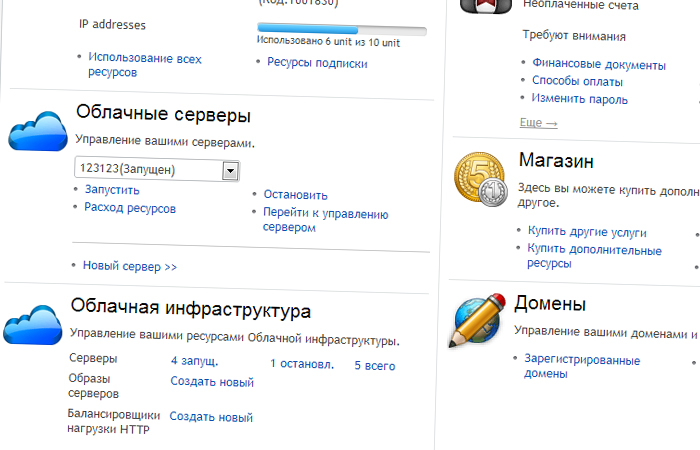
If we have already created a server once, the parameters of which completely suit us, they do not need to be written on a piece of paper. Any of the Cloud servers can be saved as an image. This is very convenient if you need to create some "reference" server images and quickly deploy machines from them.
We go to the control panel and select "Cloud Servers" → Go to server management. In the list of servers, select the desired one → by name we go to the basic information about the server (Summary tab) → click on the Create Image button.

We are required to enter only 2 parameters - the name of the image and its description (optional). Please note that during the creation of the image, the “original” automatically stops, and immediately after the completion of the process, it also automatically starts. At the same time, the notification “Image creation operation is scheduled” appears in the panel. An image of our test server was created in less than a minute.
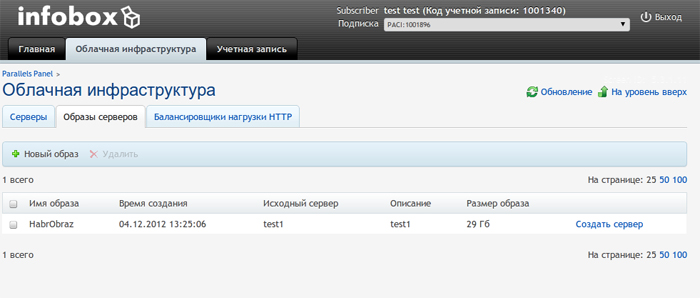
The image completely repeats the parameters of the server we selected with the exception of IP addresses. The full list of created images can be viewed in the “Cloud Infrastructure” → “Server Images” control panel. You can deploy a server from an image with the click of a button.
If you want to create several copies of a working server (for example, to add it to the balancer), you can save time by cloning them. Clones will completely repeat all the settings of the original, except for IP addresses.
We continue to work in the Cloud Infrastructure panel. In the list of servers, select the desired one → by name go to its properties ("Summary") → click the "Clone" button.
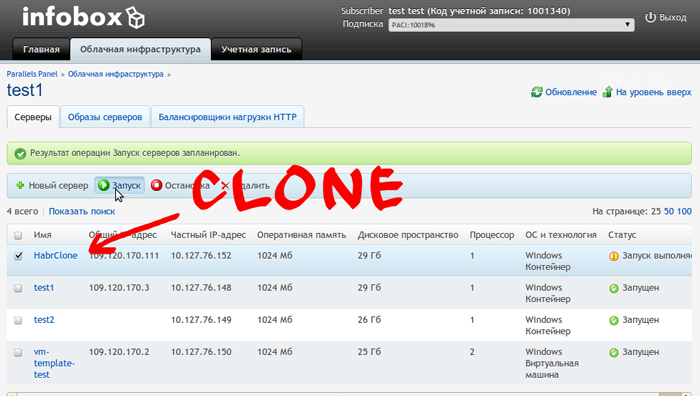
For cloning, as well as for creating an image, the “original” automatically stops and starts after the operation is completed. The clone we received will be turned off. To start it, let’s go back to the list of servers, select the server with a checkmark in the checkbox and click the “Run” button.
For stable operation of sites, you can use several copies of it on different servers. Traffic between them will distribute the load balancer. It will automatically direct visitors' requests to a freer node. The Parallels Operations Automation Cloud Infrastructure (PACI) cloud uses HAProxy software.
The balancer will be useful not only to advanced users, but also to those who plan to use the cloud simply for hosting the site. For example, if you have an online store on a cloud hosting, then before the holidays you will need to not only prepare special offers and advertise, but also clone your Cloud server and connect it to all load balancers to the load balancer. Then for sure there will be no problems with the availability of the site at the peak of traffic.
You can create and manage a balancer through the same tab in the Cloud Servers panel → HTTP Load Balancers → Add.
We need to specify the name of the balancer and select the servers that will be connected to it. The field "Register in the domain" is optional. If we need support for DNS hosting, here we can choose one of the domains associated with the account.
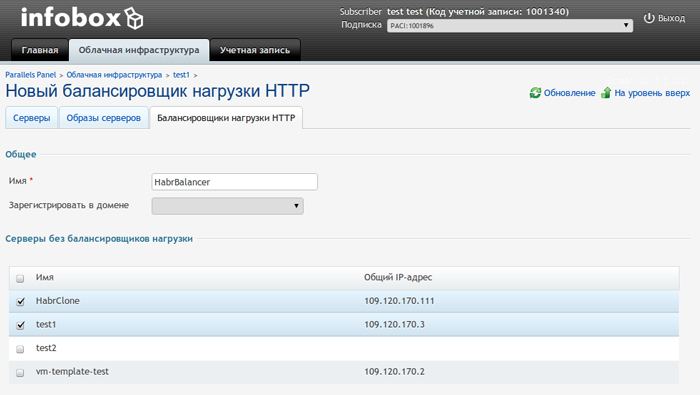
To verify that the balancer is working correctly, you can display the IP address of the server on the pages it creates. When contacting the balancer, we will receive a response variably from all the servers connected to the balancer.
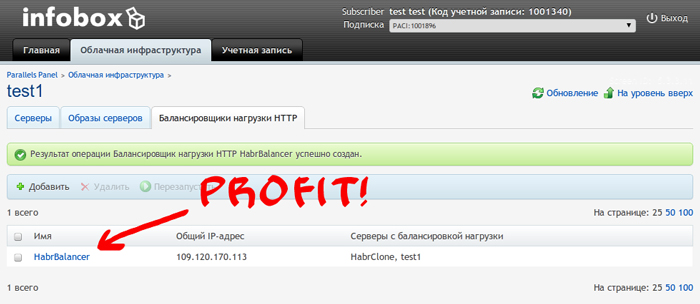
We proceed to the balancer parameters in the same way as to the server parameters - by clicking on the object name. By adding or removing the checkmarks in the checkboxes, you can change the composition of the servers in the traffic distribution scheme.
The frequency of backups is configured for each server separately. Backups are automatically scheduled. So far we have started 2 options of the schedule - daily or weekly. If one of the testers needs a different schedule, we are waiting for feedback.
If the backups were not configured when choosing the server configuration, you need to connect the option. To do this, go to the “Cloud Infrastructure” control panel → select the desired server and click on its name → on the “Summary” tab, click on “Configure”. In the server configuration, we choose from three (currently) options: do not save server backups, save daily or weekly.
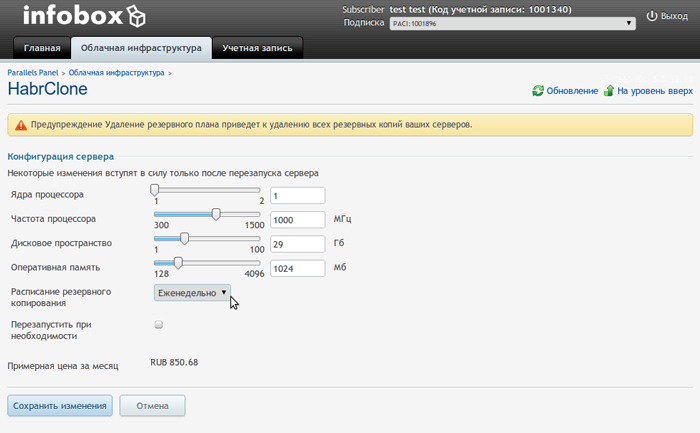
The amount of resources spent (hard disk) will depend on our choice, and, accordingly, in commercial operation, the price. The schedule will take effect after saving changes to the configuration.
In order to view information about saved backups, you need to go to the “Backups and images” tab in the server properties. Here you can restore the server using one of the saved copies. In this case, all changes made after the date of saving the copy will be lost. Just in case, before experimenting with the settings, it makes sense to save the successful option as a server image.
For the newly created server, the default security settings apply. They allow all incoming and outgoing traffic. You can make the server more secure by configuring the Firewall.
To create a rule for using the Firewall, we need to:
go to the "Cloud Infrastructure" panel → select the server for which we will install the Firewall rule → by clicking on the server name, go to its settings → on the “Firewall” tab, click the “Add” button.
In the settings, we can specify specific IPs from which incoming and (separately) outgoing traffic will be allowed. You can also select an access protocol and register secure remote and local ports.

Settings are applied immediately after clicking the "Save" button. A confirmation message “Operation result Firewall rules applied” appears in the panel.
For the security of the Cloud Server network you created, it is recommended that you open access via an external IP to only one of the servers. In this case, all the subscription servers will be accessible to each other via the internal network, and to you - through the server with an external IP acting as a router.
When you create at least 1 firewall rule, the rest of the traffic is “cut”. If you created a rule, for example, for traffic on port 3389, then traffic on port 80 will be “cut”.
You can test these and other features of Cloud Servers for free. Non-commercial testing will last until February 1, 2013 . Join now !
Attention! For the authors of the best reviews of the service, we have prepared prizes .
- Creating server images
- Server Cloning
- Create and manage a load balancer
- Backup setup
- Configure Firewall
All of them are available at the stage of non-commercial testing. Let's open the control panel of the Cloud Servers service and see how they are implemented in its interface. In fact, the control panel is just a GUI shell over the API methods that we talked about last time .

Creating server images
If we have already created a server once, the parameters of which completely suit us, they do not need to be written on a piece of paper. Any of the Cloud servers can be saved as an image. This is very convenient if you need to create some "reference" server images and quickly deploy machines from them.
We go to the control panel and select "Cloud Servers" → Go to server management. In the list of servers, select the desired one → by name we go to the basic information about the server (Summary tab) → click on the Create Image button.

We are required to enter only 2 parameters - the name of the image and its description (optional). Please note that during the creation of the image, the “original” automatically stops, and immediately after the completion of the process, it also automatically starts. At the same time, the notification “Image creation operation is scheduled” appears in the panel. An image of our test server was created in less than a minute.

The image completely repeats the parameters of the server we selected with the exception of IP addresses. The full list of created images can be viewed in the “Cloud Infrastructure” → “Server Images” control panel. You can deploy a server from an image with the click of a button.
Server Cloning
If you want to create several copies of a working server (for example, to add it to the balancer), you can save time by cloning them. Clones will completely repeat all the settings of the original, except for IP addresses.
We continue to work in the Cloud Infrastructure panel. In the list of servers, select the desired one → by name go to its properties ("Summary") → click the "Clone" button.

For cloning, as well as for creating an image, the “original” automatically stops and starts after the operation is completed. The clone we received will be turned off. To start it, let’s go back to the list of servers, select the server with a checkmark in the checkbox and click the “Run” button.
Create and manage a load balancer
For stable operation of sites, you can use several copies of it on different servers. Traffic between them will distribute the load balancer. It will automatically direct visitors' requests to a freer node. The Parallels Operations Automation Cloud Infrastructure (PACI) cloud uses HAProxy software.
The balancer will be useful not only to advanced users, but also to those who plan to use the cloud simply for hosting the site. For example, if you have an online store on a cloud hosting, then before the holidays you will need to not only prepare special offers and advertise, but also clone your Cloud server and connect it to all load balancers to the load balancer. Then for sure there will be no problems with the availability of the site at the peak of traffic.
You can create and manage a balancer through the same tab in the Cloud Servers panel → HTTP Load Balancers → Add.
We need to specify the name of the balancer and select the servers that will be connected to it. The field "Register in the domain" is optional. If we need support for DNS hosting, here we can choose one of the domains associated with the account.

To verify that the balancer is working correctly, you can display the IP address of the server on the pages it creates. When contacting the balancer, we will receive a response variably from all the servers connected to the balancer.

We proceed to the balancer parameters in the same way as to the server parameters - by clicking on the object name. By adding or removing the checkmarks in the checkboxes, you can change the composition of the servers in the traffic distribution scheme.
Backup setup
The frequency of backups is configured for each server separately. Backups are automatically scheduled. So far we have started 2 options of the schedule - daily or weekly. If one of the testers needs a different schedule, we are waiting for feedback.
If the backups were not configured when choosing the server configuration, you need to connect the option. To do this, go to the “Cloud Infrastructure” control panel → select the desired server and click on its name → on the “Summary” tab, click on “Configure”. In the server configuration, we choose from three (currently) options: do not save server backups, save daily or weekly.

The amount of resources spent (hard disk) will depend on our choice, and, accordingly, in commercial operation, the price. The schedule will take effect after saving changes to the configuration.
In order to view information about saved backups, you need to go to the “Backups and images” tab in the server properties. Here you can restore the server using one of the saved copies. In this case, all changes made after the date of saving the copy will be lost. Just in case, before experimenting with the settings, it makes sense to save the successful option as a server image.
Configure Firewall
For the newly created server, the default security settings apply. They allow all incoming and outgoing traffic. You can make the server more secure by configuring the Firewall.
To create a rule for using the Firewall, we need to:
go to the "Cloud Infrastructure" panel → select the server for which we will install the Firewall rule → by clicking on the server name, go to its settings → on the “Firewall” tab, click the “Add” button.
In the settings, we can specify specific IPs from which incoming and (separately) outgoing traffic will be allowed. You can also select an access protocol and register secure remote and local ports.

Settings are applied immediately after clicking the "Save" button. A confirmation message “Operation result Firewall rules applied” appears in the panel.
For the security of the Cloud Server network you created, it is recommended that you open access via an external IP to only one of the servers. In this case, all the subscription servers will be accessible to each other via the internal network, and to you - through the server with an external IP acting as a router.
When you create at least 1 firewall rule, the rest of the traffic is “cut”. If you created a rule, for example, for traffic on port 3389, then traffic on port 80 will be “cut”.
Test Cloud Servers for Free
You can test these and other features of Cloud Servers for free. Non-commercial testing will last until February 1, 2013 . Join now !
Attention! For the authors of the best reviews of the service, we have prepared prizes .
